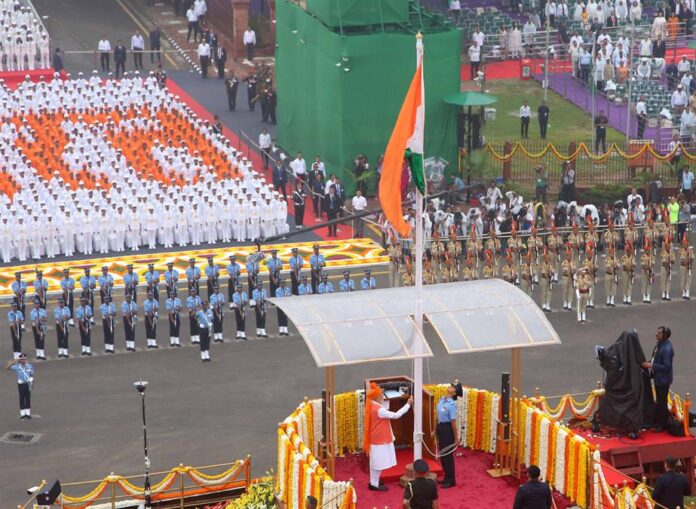By Chaitali Bag
On the 79th Independence Day, Prime Minister Shri Narendra Modi delivered his longest and most decisive Red Fort address—103 minutes that sketched a bold, coherent, and compelling vision: a self-reliant, innovative, and empowered India, Viksit Bharat by 2047. It was not just a speech; it was a call to action—an invitation to every citizen, entrepreneur, farmer, scientist, soldier, and student to shoulder the nation’s destiny with pride and purpose.
At the heart of the vision lie three foundational pillars: self-reliance, innovation, and citizen empowerment. Modi’s message was unequivocal: dependency dulls a nation’s prowess; self-reliance sharpens it. From defence to semiconductors, from clean energy to agriculture, from digital sovereignty to youth-led startups, India will build a modern ecosystem that is competitive, compassionate, and confident. The goal is audacious yet attainable: a $10 trillion economy by 2047, globally competitive, socially inclusive, and strategically autonomous.
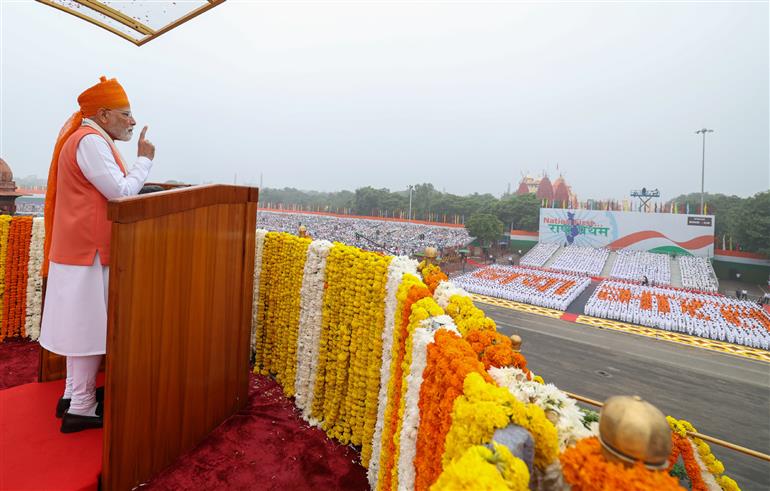
The roadmap radiates across sectors with clarity and conviction. In defence, Operation Sindoor stood as a milestone of indigenous capability—Made-in-India weapons, decisive operations, and an end to the era of nuclear blackmail. With Mission Sudarshan Chakra and a nationwide security shield by 2035, India signaled that its deterrence and response will be rapid, precise, and entirely its own. In space and nuclear energy, the horizon is equally inspiring: Gaganyaan, an Indian space station, 10 new reactors, and a tenfold rise in nuclear capacity—each step reinforcing energy independence and scientific leadership. Over 300 space startups and a surge in deep-tech innovation demonstrate a country transitioning from adopters to creators.
Toward Viksit Bharat—Democracy, Development, and Duty
On the eve of the 79th Independence Day, President Droupadi Murmu’s address offered a concise yet comprehensive reflection on India’s journey since independence and a compelling roadmap to 2047. Rooted in gratitude to the freedom fighters and mindful of the trauma of Partition, her message affirms a shared national pride anchored in the Constitution’s enduring ideals—Justice, Liberty, Equality, and Fraternity. These values, she insists, must translate into tangible access to health, education, and opportunity, thereby dignifying every citizen.
The President highlighted a resilient economy marked by strong growth, controlled inflation, and expanding exports, while asserting that good governance has reduced poverty and narrowed regional and income disparities. Infrastructure—highways, railways, metros, and urban amenities—forms the backbone of this progress, complemented by social welfare initiatives that expand coverage, such as Ayushman Bharat for all citizens above 70. Ease of living stands alongside ease of doing business, with targeted inclusion for SC, ST, OBC, and other historically marginalized groups.
India’s digital transformation is presented as both an instrument and an emblem of national capability: near-universal 4G, global leadership in digital payments and direct benefit transfers, and a bold “India AI Mission” that envisions the country as an AI hub by 2047. This technological ambition is framed within Atmanirbhar Bharat, urging citizens to favor Indian products, celebrate handloom heritage, and advance indigenous manufacturing, including in defense.
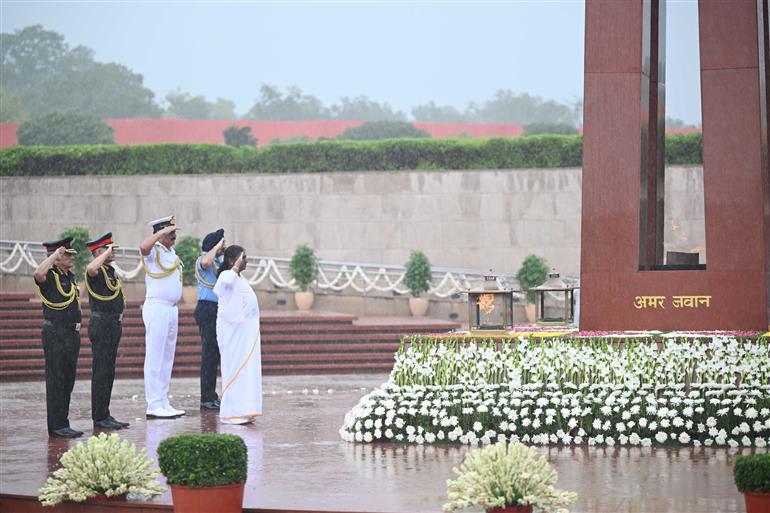
The President identified the nation’s human capital—youth, women, and communities long on the margins—as the decisive drivers of growth. The National Education Policy, a vibrant startup ecosystem, and achievements in space and sports underscore the promise of a confident, innovative India. She reinforces a zero-tolerance stance on corruption, invoking Gandhian ethics to affirm that transparency and integrity are prerequisites of a healthy democracy.
On national security, her resolve is unambiguous: condemn terrorism, ensure unity across political lines, and deploy firm, proportionate responses—exemplified by “Operation Sindoor”—while maintaining a defensive posture that protects citizens. Equally urgent is environmental stewardship: a call for lifestyle changes and a renewed relationship with land, rivers, mountains, and biodiversity, so that development remains sustainable and intergenerational justice is upheld.
Expressing gratitude to soldiers, police, CAPFs, judiciary, civil services, missions abroad, and the global Indian diaspora, President Murmu situates individual duty within a collective enterprise. Her vision for 2047—Viksit Bharat—is of a prosperous, inclusive, innovation-led nation, digitally enabled and constitutionally grounded, where equality is lived experience and opportunity is universal. The appeal is clear: every citizen must participate—through integrity, enterprise, and empathy—in shaping a developed India that is self-reliant, just, and united.
Operation Sindoor: A New Dawn of Strategic Autonomy and Aatmanirbhar Bharat
From the Red Fort, Prime Minister Narendra Modi hailed Operation Sindoor as a landmark demonstration of India’s maturing defence capabilities—one powered by indigenous technology, homegrown platforms, and the confidence to act decisively on India’s terms.
At the heart of the Prime Minister’s address was a powerful assertion: India will no longer be constrained by external pressure, nuclear blackmail, or dependence on foreign arms. The Armed Forces’ success in dismantling terror networks and Pakistan-based infrastructure using Made-in-India weapons showcased not just tactical prowess, but a civilizational shift—security anchored in self-reliance. This is strategic autonomy in action, not in theory.
The message was clear and stirring: indigenous capabilities are the bedrock of national dignity and strength. As India progresses toward Viksit Bharat by 2047, self-reliance must be more than an economic agenda—it must be a mindset. The Prime Minister’s words cut through the noise: self-reliance is not merely about balancing trade or currency; it is about the sovereign ability to stand tall, to build, innovate, and defend without asking permission.
The reaffirmation of the Indus Waters Treaty was equally resolute. “Blood and water will not flow together,” declared the Prime Minister, voicing a sentiment that resonates deeply with citizens and farmers alike. For decades, waters from the Indus system nourished fields across the border even as Indian agriculture faced constraints. The new stance signals a recalibration of policy rooted in fairness, national interest, and strategic clarity.
Perhaps the most galvanizing call was to India’s innovators and youth: build jet engines in India. This is not only a technological challenge; it is a national mission. If India could deliver vaccines at scale during COVID and revolutionize digital payments through UPI, why not master the crown jewel of aerospace propulsion? A domestically developed jet engine would transform air power, catalyze advanced manufacturing, and elevate India into the top echelon of defence tech nations. It would mean control over critical supply chains, sustained exports, and a resilient ecosystem of materials science, AI-driven design, and precision engineering.
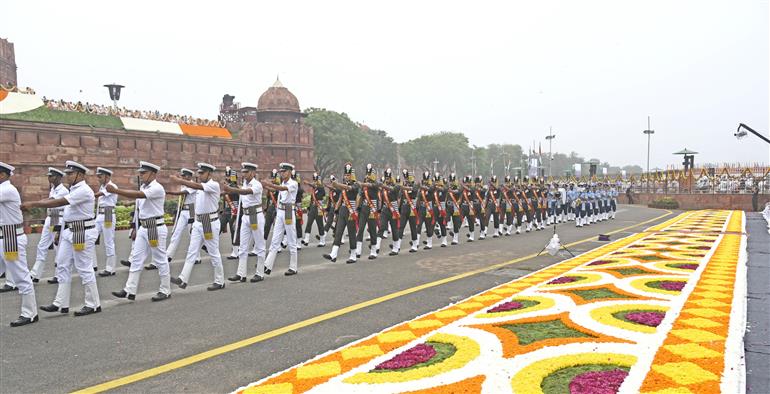
Operation Sindoor is therefore more than a military operation. It is a statement of intent—a declaration that India’s security, prosperity, and technological destiny will be forged at home, with confidence and creativity. It is a rallying cry for universities to deepen research, for industry to scale up advanced manufacturing, for start-ups to focus on dual-use innovation, and for policymakers to sustain reforms that accelerate design-to-deployment.
The vision does not stop at Earth. Celebrating the achievements of Group Captain Shubhanshu Shukla, the Prime Minister announced plans for India’s space station—another audacious leap into the future. With 300-plus start-ups already building satellites, sensors, and exploration systems, India’s space economy is surging. This is how great nations lead: by setting ambitious targets and empowering a generation of scientists, entrepreneurs, and dreamers to achieve them.
The journey ahead demands discipline and collaboration: stronger R&D pipelines, robust test facilities, agile procurement, and unwavering support for innovators. But the momentum is unmistakable. When a nation believes in its capabilities, aligns its institutions, and dares to build, it creates a virtuous cycle of pride, performance, and progress.
On this Independence Day, India did more than celebrate freedom. It redefined it. Strategic autonomy is not isolation—it is empowerment. Defence self-reliance is not inward-looking—it is world-class excellence built at home. With Operation Sindoor as proof, a jet engine challenge on the horizon, and a space station in sight, India is not just preparing for the future—it is already shaping it.
Economically, reform is being reimagined as a citizen-centric experience. Next-generation GST reforms promise relief for MSMEs and families, while faceless tax systems and decriminalized, simplified laws cut red tape and unleash enterprise. A new Task Force for Next-Generation Reforms will streamline rules, reduce compliance costs, and protect innovators from arbitrary action. The message is clear: governance must serve the people, not the other way around. The PM Viksit Bharat Rozgar Yojana will boost youth employment at scale—because demographic energy must convert into national prosperity.
The agricultural surge is no less remarkable. From record grain production to leadership in milk, pulses, and jute, the farmer stands at the center of India’s resilience. The PM Dhan-Dhanya Krishi Yojana targets 100 backward districts, while initiatives like PM-Kisan, irrigation, and livestock protection deepen confidence in rural Bharat. Fertilizer self-sufficiency, pharmaceutical R&D, and “pharmacy of the world” ambitions underscore a critical truth: food and health security must never be hostage to imports.
Technology is the soul of this transformation. India is moving from missed chances in chips to “mission mode” semiconductor manufacturing, with Made-in-India chips slated by 2025. The call to build our jet engines, operating systems, AI, and cybersecurity stack is both a challenge and a clarion cry—own the core, secure the future. The youth are urged to build India’s digital commons—social platforms, infrastructure, and data sovereignty—fortifying autonomy in an era defined by code.
Energy independence is the backbone of this century’s freedom. A thirtyfold rise in solar capacity, Mission Green Hydrogen, and a leap to 50% clean energy by 2025—five years ahead of the original target—mark a civilizational step toward sustainability. The National Critical Minerals Mission secures the inputs of the future—lithium, rare earths, and strategic resources—so India’s growth cannot be throttled by external chokepoints.
But this journey is not only about hardware and numbers; it is about identity, unity, and dignity. The Prime Minister saluted the Constitution as Bharat’s guiding light, honored heroes from Syama Prasad Mookerjee to Guru Tegh Bahadur Ji, and celebrated the centenary of the Rashtriya Swayamsevak Sangh as a testament to selfless service. Cultural pride is not ornamental—it is the crown jewel, shaping confidence. Initiatives like Gyan Bharatam to preserve manuscripts, classical status for Indian languages, and the success of the Maha Kumbh affirm that diversity is India’s strength and knowledge its compass.
Socially, the saturation approach—delivering benefits to every doorstep—has moved crores out of poverty into a neo–middle class. Women are leading from the front: Lakhpati Didis, Namo Drone Didi, and the surge of women in startups, sports, forces, and science are rewriting India’s growth story. Regions once torn by Maoism are now green corridors of development; the tricolor now flies where fear once ruled.
This speech was infused with resolve: on borders and within, on economy and ecology, on heritage and high-tech. “Blood and water will not flow together,” he declared, signaling a firm relook at unjust arrangements and a resolute stance on terrorism. Yet the tone remained inclusive—Vocal for Local, Swadeshi with pride, zero-defect-zero-effect quality, and citizens as co-builders of prosperity. Even small acts matter: a “Swadeshi” board at a shopfront, a 10% reduction in cooking oil at home, a young coder building a secure Indian app, a farmer adopting new irrigation—each an act of nation-building.
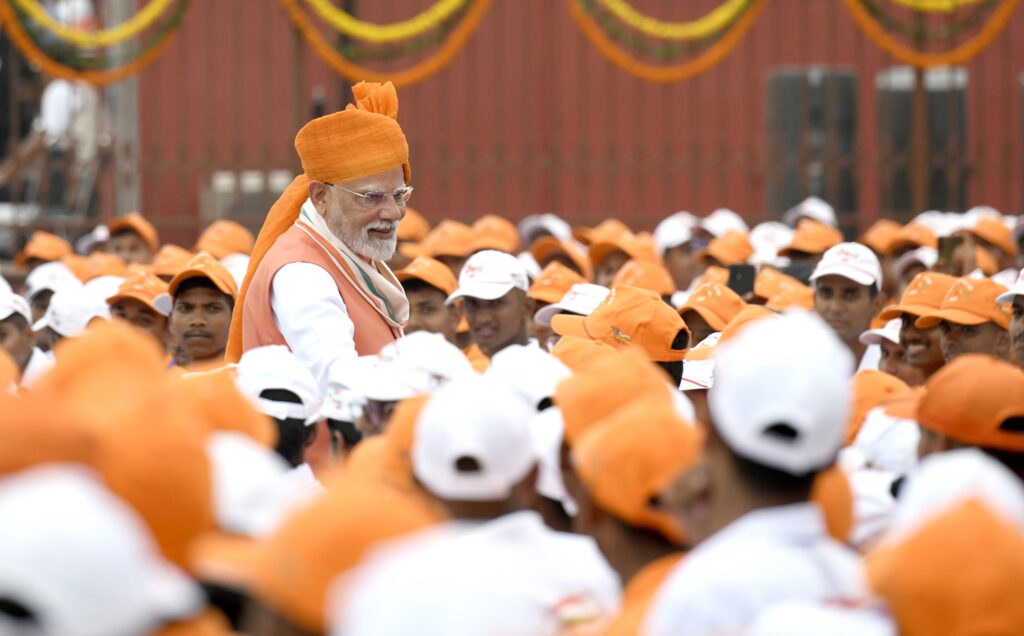
Viksit Bharat by 2047 is not a distant dream. It is a disciplined march powered by reforms, a billion aspirations, and the courage to build what we once imported. It asks us to shed every trace of mental and systemic slavery, to keep unity as our mantra, and to move together with speed and scale.
This is India’s moment—to extend our line of progress without being trapped by others’ limits. From the ramparts of the Red Fort, the message soared: we will neither stop nor bow. With self-reliance as bedrock, innovation as engine, and citizens as the heartbeat, a confident, clean, capable, and compassionate India will stand tall in 2047—Viksit, resilient, and free.
For centuries, music has been the heartbeat of India’s military heritage, and the Indian Air Force Bands carry that legacy with stirring pride and precision! Born in 1944 at Kohat on the North Western Frontier, the IAF Band has grown into nine vibrant ensembles stationed across the nation, uniting audiences with a rich blend of Indian and Western compositions. From the grandeur of the Independence Day Ceremony and Republic Day Parade to the Air Force Day Parade, their performances illuminate India’s cultural tapestry while uplifting the spirits of air warriors and civilians alike. Showcasing the nation on global stages and energizing the “Know Your Forces” initiative, these bands turn melodies into bridges of camaraderie and patriotism. This Independence Day 2025, their rousing notes echoed across iconic venues—from Ambience Mall, Vasant Kunj in New Delhi to the War Memorial in Guwahati, Chandra Shekhar Azad Park in Prayagraj, Shaniwar Wada in Pune, Shanghumukham Beach in Thiruvananthapuram, Gateway Brigade Lake in Bengaluru, Golconda Fort in Hyderabad, and Futala Lake in Nagpur—spreading unity, pride, and the indomitable spirit of the Indian Air Force.

